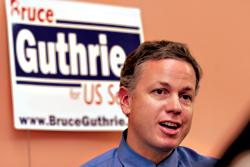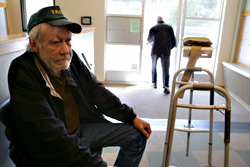For the past two decades, the homelessness problem has been an albatross around America’s neck. No one likes the idea that there are so many people with nowhere to spend the night, but whether they are begging for change or leaning against a wall looking lost, it’s hard to know what to do when you encounter them.
Homelessness first became a big issue in the U.S. during the 1980s, when bedraggled men and women hit the streets of major cities in great numbers. Some were Vietnam veterans, some were mental patients turned out of state mental hospitals after a cost-cutting initiative championed by President Ronald Reagan. Countless blue-ribbon commissions and well-meaning citizens and politicians have tried to find a way to end this problem. None of them has succeeded. Today, America has 750,000 homeless people, according to the National Alliance to End Homelessness. In King County, the annual One Night Count of homeless people puts the local number at an estimated 8,300.
King County is about to take a stab at reducing that figure—to zero. On July 11, King County Executive Ron Sims, business leaders, government officials, and homeless advocates rolled out a 10-year plan to end county homelessness once and for all. But it’s a plan that some advocates for the homeless say falls short because it doesn’t address underlying economic issues.
The plan aims to end homelessness by “putting a roof over every bed” and thereby eliminate homelessness instead of merely managing the problem. The plan estimates that it will take 9,500 units of long-term, low-income housing to meet that goal, as well as aggressive integration of mental-health care and substance-abuse treatment. About 40 percent of the homeless surveyed in the One Night Count reported mental-health issues.
Jeff Natter, project director of the county’s Coalition to End Homelessness, says that’s a lofty goal, but an achievable one. It will, he says, move King County away from a system where the homeless wind up in shelters such as the Downtown Emergency Service Center on Third Avenue and in short-term transitional housing. Such people often return to the streets once out of transitional housing because there is limited long-term housing available. And housing, he says, is the key to ending homelessness.
“This is a housing-first model,” Natter says, adding that it will better integrate wraparound social services into the process. The plan is similar to those in other major metropolitan areas around the country and seems to get results. San Francisco experienced a 28 percent drop in homelessness between 2002 and 2004. Fewer homeless people died on the streets as well.
None of this will come cheap in King County.
Natter estimates that it will cost from $680 million to $1 billion over 10 years to house the homeless. The 10 Year Plan operates on the assumption that much of that money currently exists among a wild scramble of social service and housing dollars already going to hundreds of agencies in King County. The trouble is that all of those agencies do not work together, resulting in a system so fragmented that no one can estimate how much money is in play now, or how much could be funneled into housing units. “Some who are serving the homeless are doing it in a piecemeal way, and we need to do a better job of consolidating services,” Natter says.
In fact, the social services system is so fragmented that the county doesn’t have a handle on how many agencies work with the homeless. A recent, admittedly incomplete count by the Coalition to End Homelessness found approximately 90 agencies with 260 emergency shelter and transitional housing programs in King County.
Starting next month, the county expects to bring together these agencies to try and figure out just how much money is out there. The hope is to begin to achieve cost savings by decreasing duplicated services. In addition, the county plans to tap a recently created state fund, financed by a tax on real-estate titles, that could pump from $3.5 million to $5 million a year into housing in King County.
The plan is mute on how many housing units will result. Natter says the county currently has 5,000 units in place and will need to build 4,500 new ones.
Looming over all these good intentions are planned rollbacks in social spending by the federal government, which traditionally funds many of the programs geared toward the homeless. By one estimate, 370,000 families will be cut by 2010 from Section 8, the federal housing subsidy program, under current Bush administration budget projections.
That’s where the county hopes the public will get involved—by making a collective decision that homelessness is unacceptable and by advocating program funding.
As interesting and visionary as the plan sounds, it is short on specifics. Natter says that will be the case for much of the next year as politicians and social service providers gauge how the county’s crazy quilt of social programs can work together.
Less clear is the source for the other half of the money to achieve the plan’s housing goals. In the current political climate, the federal government is unlikely to pony up. Some who work with and study the homeless are not convinced the plan can succeed, even if the Bush administration suddenly turns into a house full of compassionate conservatives. “The biggest flaw is that it treats homelessness as a social services problem,” says Tim Harris, executive director of Real Change, the weekly community newspaper sold by the homeless around Seattle. Harris has been working on homeless causes since the mid-1980s, and he says this plan offers nothing to address how the homeless, once off the streets, will find livable-wage jobs. “I don’t see the plan heading in that direction,” he says. Says Diana Pearce, director of the Center for Women’s Welfare at the University of Washington School of Social Work: “As long as we do this kind of Band-Aid approach, we are not going to end homelessness.”
Harris and Pearce both point to the economic reality facing those fresh from the streets, especially if they are faced with footing some of the rent in the county’s planned low-income housing. (Federal rules, for example, usually require that residents pay one-third or more of their income toward rent.) Minimum-wage jobs pay $7.35 an hour. A 2001 study by the Washington Association of Churches pegged the self-sufficiency standard for rent, food, and transportation, etc., at $9.61 an hour for a single person in King County and at $11.76 per hour for each parent in a traditional four-person household. There simply aren’t many jobs in the Seattle area that pay that much for low-skilled workers, say Harris and Pearce.
Even Seattle City Council member Nick Licata recently expressed skepticism about the plan, wondering if shifting money from emergency resources would create unworkable gaps in the social services safety net—and create the need for even more funding.
The King County Council is set to review the plan next month, the first step before it is enacted.








